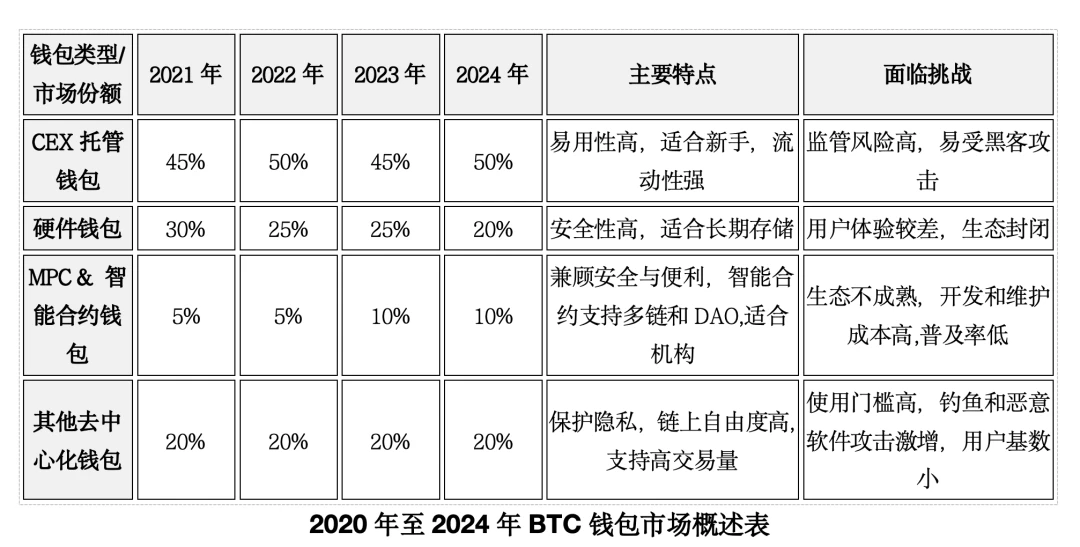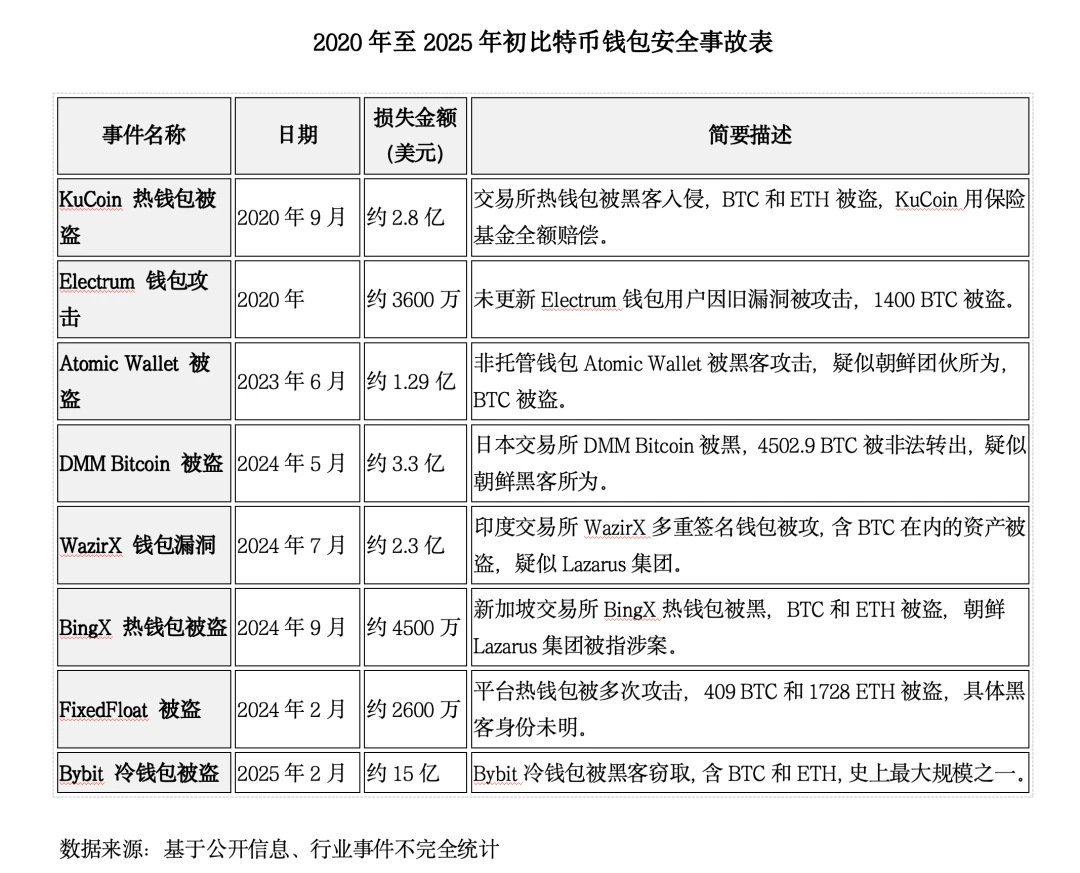introduction
Is the BTC wallet a tool for storing coins or an entrance to the ecosystem?
Since the birth of Bitcoin, wallets have always stood on the opposite side of security and convenience. If you want absolute security, you must keep your private key yourself, even if it means you cannot get it back if you lose it; if you want more convenience, you have to rely on centralized custody, which means losing control of your assets. For ten years, this tug-of-war has never stopped.
But the market has given a new answer. The number of cryptocurrency holders worldwide has exceeded 600 million, and the demand for asset management far exceeds simple storage. CEX wallets still dominate traffic, but non-custodial wallets are growing rapidly, and new models such as MPC and smart contract wallets continue to emerge, trying to find the best solution between security and experience. BTC wallets are no longer just a place to store coins, but have become the traffic entrance for the entire Bitcoin ecosystem.
The battle for wallets has long gone beyond the competition for market share, and is now a game about rule-making. In this game of technology, capital, and regulation, whoever can find a balance between security, compliance, and user experience will be able to control the future direction of BTC.
Just like ten years ago, our concern was how to store BTC; today, the fight is about who BTC should belong to in the future.
1. Panorama of BTC wallet market: explosive growth and ecological differentiation
The BTC wallet market is not only expanding in scale, but also reshaping its functional boundaries. Bitcoin wallets, once simply seen as a coin storage tool, have now become the frontier battlefield of Bitcoin ecological competition. In the past few years, the market has undergone tremendous changes. Bitcoin ETF has accelerated the entry of institutional funds, Ordinals inscriptions have become popular, and the demand for on-chain transactions has skyrocketed. The market size of BTC wallets has doubled from US$8.42 billion to US$10.51 billion in just a few years. The crazy growth of the market has not only brought an influx of funds and users, but also caused different types of wallets to start a competition for the entrance - CEX custody, hardware wallets, and emerging wallets, each scrambled for territory, trying to control the traffic entrance of the BTC ecosystem.

Data source: Based on Glassnode active address data (38 million in 2021 to 45 million in 2024), Chainalysis trend report, wallet vendor market performance, and incomplete statistics of industry events
CEX custodial wallet: traffic hegemony and trust crisis
The first Bitcoin of a user is most likely purchased from an exchange. This gives CEXs such as Binance and Coinbase a first-mover advantage in the wallet competition. Relying on ETF custody, Coinbases managed BTC assets soared to $171 billion in Q1 2024, while Binance Web3 wallet quickly expanded to 6 public chains, trying to connect transactions and DeFi scenarios.
But after the collapse of FTX, the trust crisis of CEX wallets was completely detonated: users began to re-examine the risks of centralized custody, causing the sales of hardware wallets to surge 2.3 times in 2023, and more and more people are looking for safer ways to manage assets. Faced with challenges, CEX wallets began to introduce MPC (multi-party computing) technology, trying to find a balance between compliant custody and user autonomy, but for many users, decentralization still means distrust of third-party custody.

Image source: Internet
Hardware wallets: security barrier or ecological island?
As traditional non-custodial solutions, hardware wallets such as Ledger and Trezor have long held 60% of the global market share. However, as Ordinals empowers the BTC ecosystem, the demand for on-chain interactions has surged, and hardware wallets have gradually become ecological islands due to their closed systems. In order not to be left behind by the progress of the times, products such as Ledger Live and Trezor Suite have begun to try to support NFT and multi-chain asset management, but data shows that users are more willing to sacrifice 5% of security in exchange for 80% of convenience, and the market barriers of hardware wallets are gradually being weakened.
Emerging wallets: dimensionality reduction and reshaping user experience
What really stirred up the market was a group of anti-traditional emerging players:
Fireblocks: Through MPC technology, 1,500 institutions including Goldman Sachs can safely custody nearly $200 billion in assets, impacting traditional custodians.
UniPass: Remove mnemonics and use email login instead, attract hundreds of thousands of retail investors within half a year, and simplify the usage threshold of BTC Layer 2.
Stacks: Through built-in incentives in the wallet, 64% of users hold STX tokens, creating a Bitcoin version of the “points system”.
At this time, the competition among wallets is no longer just a competition for market share, but a competition for ecological dominance. However, in this war, wallets have not found the optimal solution, but are instead caught in multiple challenges in technology, security, and user experience. CEX, hardware wallets, and emerging wallets are each betting on different futures:
The ideal of decentralization, the reality of user experience, and the bottom line of security, the struggle between these three is pushing BTC wallets into a more complicated battle.
2. Landing Dilemma: Three Major Survival Challenges
The growth of the market size does not mean that BTC wallets have found the optimal solution. On the contrary, the expansion of the user base and the increase in transaction activity are making the shortcomings of BTC wallets more and more obvious. The three major problems of main network congestion, hacker attacks, and complex operations not only trouble developers, but also continue to discourage new users. Bitcoin wallets are facing a survival challenge that will determine their future.

Mainnet congestion
The main network is not smooth, causing transaction costs to soar and performance difficulties to intensify. Once upon a time, the congestion of the Bitcoin main network was comparable to that of Beijings East Third Ring Road during the morning rush hour. The launch of the Runes protocol and the halving of the market, the single transaction fee was as high as $128, leaving ordinary users in a dilemma of transferring is more expensive than the asset itself. Although Layer 2 solutions continue to emerge, their performance is still limited, and the on-chain confirmation time is too long, resulting in obstructions to small payments and interactive experience. The optimization of BTC wallets is no longer just a matter of reducing transaction costs, but how to enable users to achieve a smooth experience without being discouraged by technical barriers.
Security Challenges
The essence of security challenges is the dilemma of hackers, private keys, and user trust. The security of Bitcoin wallets has always been a cat and mouse game. In the past five years, the cumulative losses from hacker attacks caused by wallet vulnerabilities have exceeded US$3 billion. Among them, the Atomic Wallet vulnerability in 2023 led to the theft of multiple crypto assets worth more than US$100 million, exposing the technical risks of non-custodial solutions. But the problem is not just hacker attacks. Problems such as lost mnemonics, chaotic private key management, and cross-chain bridge vulnerabilities make it difficult for ordinary users to deal with security. The higher the security threshold, the greater the cost of using a decentralized wallet, which ultimately leads many users to return to the embrace of centralized custody.
User experience dilemma
The user experience facing the market is complicated and difficult to break through the circle of novice users - It takes five minutes to download the wallet and two hours to understand the operation. The high learning threshold of Bitcoin wallets is the common experience of almost every novice BTC user:
68% of new users got stuck during their first transfer due to incorrect calculation of gas fees;
It takes an average of 3 hours for an average user to complete their first cross-chain interaction;
Only 9% of BTC Layer 2 users truly understand the Gas token mechanism.
The essence of the user experience gap is not a UI design problem, but the Bitcoin ecosystem still lacks adaptation for ordinary users. Although some wallet manufacturers have been trying to reduce complexity: canceling mnemonics and using email login instead, automating the staking process to earn interest with one click, and using zero-knowledge proof technology to shorten cross-chain time... But they still have not changed the core pain point of BTC wallets-users must understand private keys, gas fees, and on-chain interactions to truly control their assets. For ordinary people, this still means too high a threshold, which is not only a problem of user habits, but also a key variable for whether BTC wallets can truly enter the mainstream in the future.
Faced with these difficulties, BTC wallets are going through a critical decision: Will they become a safer and more efficient financial infrastructure, or will they be gradually eliminated by users in the face of difficulties? However, what really determines the future of wallets may not be simple technical optimization, but a deeper battle for ecological dominance. When the shortcomings of user experience threaten the basic base of hundreds of millions of users, a war on the definition of BTC wallets is inevitable.
3. Reconstruction of power of BTC wallets: Who can define the next ten years?
Who can define the next decade? The answer may come down to who can truly dominate Bitcoin. When elements such as DeFi, Layer 2, and financialization come in, the role of Bitcoin has completely changed. Wallets not only determine how BTC is stored, but also how BTC is used - and whoever can control the flow of BTC funds can control the rules of the ecosystem. But the problem is that Bitcoin still has no absolute leader. The competition between technology, capital, and ecology continues, and each force is trying to define the future of BTC.
1. Technical route: Does BTC still insist on decentralization?
The split of Bitcoin wallets reflects two different directions of the BTC ecosystem: to maintain decentralization or to cater to the needs of a wider range of users?
On the one hand, the complexity of the technology still daunts ordinary users, and decentralized wallets still require users to manage their own mnemonics and calculate gas fees. Over the past decade, the technical upgrades of BTC wallets have focused more on security rather than lowering the threshold.
On the other hand, new technical routes are breaking through these limitations. Account abstraction (AA), social recovery, on-chain identity and other solutions are trying to make Bitcoin more invisible. But does this mean that the BTC ecosystem is compromising with Web2? The choice of BTCs technical route not only affects the future of the wallet, but also determines whether Bitcoin will eventually become a closed value storage tool or a currency that can be truly used in daily life.
2. Capital Game: Is BTC still decentralized finance?
If technology determines how BTC is used, then capital determines the financial attributes of BTC.
CEX (centralized exchanges) are transforming BTC with a regulatory system, ETFs make BTC a compliant asset, and the custody model allows BTC to be gradually controlled by institutions. Is Bitcoin becoming another digital gold?
The decentralized ecosystem is still trying to regain control of BTC. Layer 2 staking and decentralized custody solutions are still developing. The BTC DeFi ecosystem is taking shape, but whether it can challenge CEX remains in doubt. Will BTC be part of the global financial order or a core asset in the Web3 world? This is not only a technical issue, but also a choice of capital.

Image credit: Grok
3. The ultimate battle of wallets: Who truly defines BTC?
In this fragmented ecosystem, the future of BTC is still uncertain. But one thing is certain: wallets have become the key entry point for BTC funds to flow, and the power that controls wallets is also reshaping the financial rules of Bitcoin. Bitcoin is no longer just the evolution of code rules, but a game field for global economic power:
If CEX wallets dominate, BTC may become a global reserve asset, be incorporated into the traditional financial system, and be more deeply affected by regulation.
If the DeFi ecosystem can win more users, BTC may form an independent on-chain financial system and truly become the pillar of the decentralized economy.
If technological breakthroughs bring about lower barriers to entry, BTC may even become a payment tool used daily by users around the world.
Last words
To whom should BTC belong in the future? The answer to this question has gone beyond the competition between products and markets and has become the final battlefield to determine the form of Bitcoin.
The war of Bitcoin wallets may not have a clear ending. The essence of this war is the ultimate showdown between Bitcoins code is law and user first, and wallets are the front line of the confrontation between the two.
CEX is building a compliant financial system, Layer 2 is trying to bring BTC into the world of smart contracts, and smart wallets are lowering the threshold to allow more people to enter the crypto world. They are all defining different futures for BTC, but the ultimate winner may not be any of them.
The Bitcoin ecosystem is entering a new decade. It is still evolving, expanding, and looking for the form that best suits it.
Today, we are seeing the competition of Bitcoin wallets, the game, and the interweaving of power between technology, capital, and ecology. But ten years later, when we look back at today, we may truly understand how this battle for BTC wallets has shaped the future of Bitcoin.
The ecological rules of Bitcoin are still evolving and have not yet been finalized. The end of the wallet war may be further away than we think.
Disclaimer: All images, data and information used in this article are from the Internet and are for reference only. If there are any copyright issues, please contact us in time and we will deal with it accordingly. The opinions, data and analysis in this article only represent the authors personal opinions and do not constitute any investment advice. All statistical data are from public channels. Although we try our best to ensure the accuracy of the information, we do not guarantee its completeness and timeliness. Please make your own judgment and verification.










